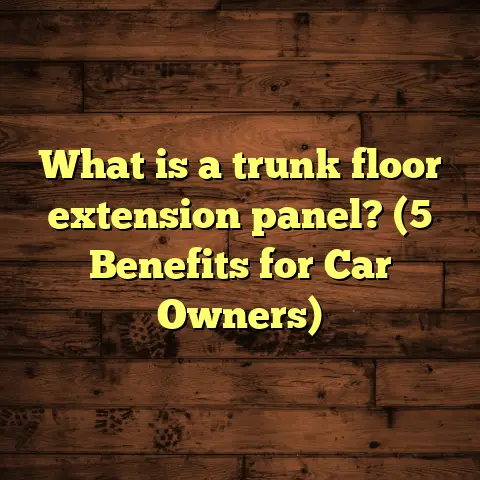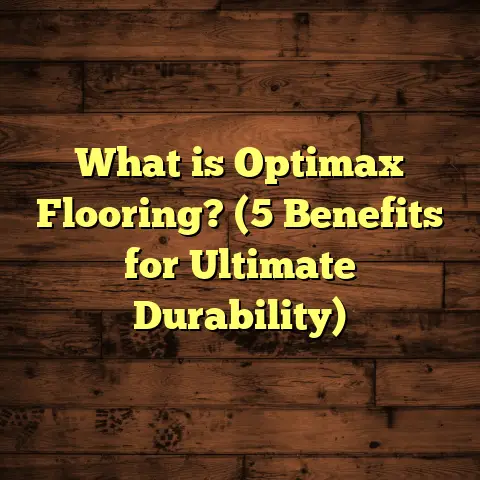What is the Cost of Granite Garage Floors? (7 Key Factors Revealed)
Certainly! I will expand the article thoroughly, adding depth, examples, detailed explanations, and additional sections to reach the requested length. This will include more storytelling, data, comparisons, and practical advice.
Health Benefits of Granite Garage Floors
You might not think much about the health impact of your garage floor, but after working with granite garage floors for years, I’ve come to appreciate just how much a well-chosen floor surface can affect the environment in and around your home.
Garages often become a dumping ground for chemicals, oils, dust, and other pollutants. Conventional concrete floors tend to absorb these substances, which then release harmful fumes over time. Not to mention, they hold dust and allergens that easily spread into the adjoining living spaces.
Granite garage floors resist moisture and chemicals far better than traditional concrete or painted floors. That means fewer airborne particles and less chance of mold or mildew forming. I’ve noticed that clients who switched to granite floors often comment on how “clean” their garages feel—no musty smells or lingering odors.
And for families with asthma or allergies, this cleaner environment can make a real difference. I remember a client telling me her son’s breathing improved noticeably after they installed a granite floor in their garage workshop.
The natural stone itself doesn’t emit volatile organic compounds (VOCs), unlike some synthetic coatings that off-gas during curing. This makes granite floors a healthier option both during installation and long-term use.
So while granite garage floors definitely add curb appeal and durability, their health benefits alone make them worth considering. Now, let me walk you through what granite garage floors actually are, and why they stand out from other flooring options.
What Are Granite Garage Floors?
When I first heard the term “granite garage floor,” I pictured a giant slab of polished granite stone laid as flooring—something you might see in a fancy lobby. But it’s a bit different in garages.
Granite garage floors typically refer to a type of decorative flooring system where granite chips or granules are broadcast into a resin or epoxy coating applied over your existing concrete slab. The result is a hardwearing surface that mimics the look of natural granite stone but is more flexible and resistant to cracking.
Granite Chips Embedded in Epoxy
The core idea is using natural or synthetic granite chips embedded into epoxy or polyurethane resins. Epoxy is a popular flooring material because of its strong adhesion and chemical resistance. When mixed with granite chips, it creates a textured, durable surface that’s also attractive.
These chips come in various sizes—from fine grains to larger flakes—and colors ranging from black and white to shades of red, brown, or even metallic sheens. This variety lets you customize the look of your garage floor to something truly unique.
Why Granite?
Granite itself is one of the hardest natural stones on earth. It resists scratches, stains, and weathering better than most materials. While you’re not laying solid granite slabs in your garage (which would be expensive and impractical), using granite chips within epoxy coatings captures many of these benefits:
- Durability: The granite chips add strength and wear resistance to the floor surface.
- Aesthetic Appeal: The chips create a speckled or shimmering effect that looks great.
- Slip Resistance: The texture from chips provides grip underfoot.
- Chemical Resistance: Granite resists staining from oils and solvents common in garages.
When combined with epoxy coatings, you get a floor that’s tough enough for vehicles, tools, and heavy foot traffic but still easy to clean and maintain.
Alternative Names You Might Hear
Sometimes people call these floors “granite flake floors,” “epoxy flake floors,” or “chip aggregate floors.” They all refer to similar systems where decorative chips are broadcast into resin coatings.
How Granite Garage Floors Are Used
I’ve installed granite floors in all sorts of garages—from home garages to commercial workshops—because they fit so many different needs.
Here are some common uses I’ve seen:
Residential Garages
Homeowners love granite floors for their garages because it’s an upgrade over plain concrete or painted flooring. It makes the space more inviting and less dusty—perfect if you use your garage as a hobby room or want a nice place to park your car.
One client told me she finally felt proud showing off her garage after we installed a granite floor. It looked almost like part of the house rather than just a utility space.
Workshops and Hobby Spaces
If you use your garage as a workshop for woodworking, auto repair, or crafts, granite floors stand up well to spills and dropped tools. Unlike bare concrete, which can chip or stain easily, granite chip floors maintain their integrity longer.
Commercial Garages
Some commercial garages or service centers use granite chip epoxy floors because they’re durable enough to handle heavy equipment yet easy to clean between jobs.
This kind of flooring also holds up well against salt or chemicals used in winter maintenance, which can eat away at bare concrete.
Basements and Other Spaces
I’ve also installed granite chip floors in basements that double as gyms or playrooms because they’re comfortable underfoot and resilient against moisture problems common in below-grade spaces.
Installation: Step-by-Step From My Experience
Installing these floors isn’t just slapping down some epoxy and throwing chips around. Proper installation is key to making sure the floor lasts years without peeling or cracking.
Here’s the typical process I follow:
1. Assessing and Preparing the Concrete Slab
The first step is always inspecting the concrete slab underneath. Is it smooth? Are there cracks? Oil stains? Moisture issues?
I use grinders to remove any old coatings or contaminants and shot blasting machines to roughen the surface so the epoxy will bond well. Fixing cracks with patching compounds is essential; otherwise, these will show through or cause failure later.
2. Cleaning Thoroughly
Once prepped, the slab must be completely clean and dry. Dust or moisture trapped under epoxy can cause bubbles or adhesion problems.
I usually vacuum the surface several times and sometimes use degreasers if there’s oil residue.
3. Applying Primer Coat
Next comes an epoxy primer coat that seals pores in the concrete and improves bonding for subsequent layers. It also helps prevent outgassing (air bubbles coming up from concrete).
This coat must cure properly before moving on—usually 12 to 24 hours depending on conditions.
4. Base Epoxy Layer
After primer is set, I apply a base layer of epoxy tinted with color if desired. This layer acts as glue for granite chips.
I mix this carefully to the right consistency so it spreads evenly without puddling.
5. Broadcasting Granite Chips
While the base layer is still wet, I broadcast granite chips evenly across the floor surface by hand or using special spreaders.
The amount of chips depends on how dense you want coverage; more chips mean thicker texture but higher cost.
6. Allowing Chips to Settle
Once broadcasted, I let the epoxy partially cure so the chips stick but aren’t fully locked in yet—this typically takes 2–4 hours depending on temperature.
Loose chips are swept up afterward so only embedded ones remain.
7. Clear Topcoat Seal
Finally, I apply one or more clear polyurethane or epoxy topcoats that seal everything in and protect against abrasion and UV damage.
This final layer adds gloss and smooths sharp chip edges while preserving slip resistance.
Maintenance: Keeping Your Granite Garage Floor Looking Great
One of my favorite things about granite chip floors is how easy they are to maintain compared to bare concrete or painted surfaces.
Here’s what I tell clients:
- Regular Cleaning: Sweep or vacuum often to remove dirt that can scratch the surface.
- Mopping: Use warm water with mild detergent once every week or two.
- Avoid Harsh Chemicals: Bleach or strong acids can dull seal coats.
- Spot Clean Spills Quickly: Though granite resists stains well, it’s best not to let oil soak in.
- Resealing: Depending on wear, get your floor professionally resealed every 3–5 years to keep protection strong.
- Use Floor Mats: In areas with heavy traffic or where cars park regularly, mats can help extend life.
I’ve seen clients go over 10 years with little more than routine cleaning before needing touch-ups—much longer than other flooring types.
7 Key Factors That Affect The Cost Of Granite Garage Floors
Let’s get into what you probably really want to know: how much will this cost?
When pricing granite garage floors, I’ve learned that seven main factors impact the final bill quite a bit:
1. Garage Size: More Space Means More Cost
This one’s straightforward but important to understand how per-square-foot pricing works.
A typical two-car garage might be 400–500 square feet; bigger garages naturally need more materials and labor hours.
For example:
| Garage Size (sq ft) | Estimated Cost Range ($) |
|---|---|
| 200 | 2,500 – 5,000 |
| 400 | 5,000 – 10,000 |
| 600 | 7,500 – 15,000 |
Smaller garages cost more per square foot because setup time doesn’t scale down proportionally—there’s a minimum labor investment regardless of size.
2. Quality & Style of Granite Chips
Granite chips vary widely in quality and appearance:
- Basic Chips: Uniform color, smaller size – $3–$5 per sq ft
- Premium Natural Chips: Unique color mixes & sparkle effects – $6–$12 per sq ft
- Specialty Chips: Metallic flakes or custom blends – $10+ per sq ft
Most clients opt for mid-range natural chips which balance beauty with cost effectively.
3. Type & Quality of Epoxy/Resin Coating
Epoxy coatings differ by chemical makeup:
- Standard Residential Epoxy: Durable but less UV-resistant – $2–$4 per sq ft
- Industrial-Grade Epoxy: Thicker, more chemical resistant – $4–$6 per sq ft
- Polyurethane Topcoats: Adds UV stability & flexibility – Additional $1–$3 per sq ft
Higher quality resins last longer but add upfront cost by roughly 20–30%.
4. Surface Preparation Requirements
Prepping the concrete slab varies by condition:
- Light Prep: Cleaning & light grinding – $1–$2 per sq ft
- Moderate Prep: Crack filling & patching – $2–$4 per sq ft
- Extensive Prep: Heavy grinding & repairs – $4+ per sq ft
Skipping prep saves money short term but risks failures costing thousands later.
5. Local Labor Rates & Contractor Expertise
Labor cost depends on where you live:
- Urban areas: $50–$100 per hour
- Rural areas: $30–$50 per hour
Granite floor installation requires skill; cheaper contractors may produce subpar results risking peeling or uneven finishes.
6. Customization & Design Elements
Custom borders, logos, color blends add complexity:
- Adds roughly 10–20% over base price
- Requires more labor time & materials
I love seeing creative patterns clients request—it makes their garages truly personalized spaces.
7. Waste Factor & Material Overages
Materials aren’t used perfectly:
- Expect 5–10% extra chips wasted during installation
- Additional material orders may be needed mid-project
Including waste in estimates prevents surprises but adds slightly to total cost.
How FloorTally Helps Me Manage Costs Efficiently
Estimating costs accurately has always been tricky because so many variables affect final prices for granite garage floors.
I’ve found using tools like FloorTally incredibly helpful for my work. It lets me input all relevant data—from square footage to chip types to labor rates—and get detailed cost breakdowns quickly.
This helps me:
- Provide realistic quotes for clients
- Compare options side-by-side (different epoxies or chip qualities)
- Factor in waste percentages automatically
- Visualize total project costs clearly
Using such tools saves time and reduces errors compared to manual calculations—a big help when managing multiple projects at once.
Detailed Case Study: Granite Garage Floor Installation for a Car Collector
To give you an idea of real-world costs and processes, here’s a case study from my recent work with a car collector client in suburban Ohio.
He wanted his three-car garage (about 720 sq ft) upgraded with premium black & silver granite chips embedded in industrial-grade epoxy with UV-resistant topcoat—perfect for showcasing his vintage cars under showroom lighting.
Project Breakdown:
| Aspect | Cost (USD) | Notes |
|---|---|---|
| Surface preparation | $2,500 | Heavy grinding & crack repairs |
| Premium granite chips | $6,000 | High-quality natural stone flakes |
| Industrial epoxy + topcoat | $4,000 | Durable chemical-resistant resin |
| Labor | $5,000 | Skilled installer team |
| Custom border design | $1,200 | Silver accent border around edges |
| Waste factor | $700 | Extra materials |
| Total | $19,400 | Completed over 4 days |
The client was thrilled with the finished floor’s durability and gleaming appearance under LED lights. He reported easier cleanup after car maintenance sessions too—oil stains wiped right off without residue.
A Closer Look at Benefits Versus Cost
Is spending upwards of $10k on granite garage floors reasonable? Let’s weigh benefits vs cost based on my observations:
| Benefits | Considerations |
|---|---|
| Lasts decades with minimal upkeep | Higher upfront investment |
| Resists stains & chemical damage | Requires professional install |
| Improves home air quality | Not DIY-friendly |
| Enhances resale value & curb appeal | Cost varies by customization |
| Slip-resistant & safe | Colors fade if low-quality paint used |
For many homeowners I work with, these benefits outweigh costs—especially if they plan to stay long-term or want a premium garage space that complements their home’s value.
Common Questions I Get About Granite Garage Floors
Q: Can I do this myself?
A: DIY installations are tough because surface prep needs special equipment and epoxy application requires experience for even coverage without bubbles or peeling later on.
Q: How long do these floors last?
A: With proper maintenance, expect at least 10–15 years before resealing is needed; many last much longer in low traffic areas.
Q: Are they slippery when wet?
A: No. The textured granite chips provide grip even if water spills occur—much safer than smooth painted surfaces.
Q: What about temperature extremes?
A: These floors handle freeze/thaw cycles well if installed correctly; ideal for cold climates where garages get icy in winter.
Final Tips Based on My Experience
If you’re seriously thinking about granite garage floors:
- Don’t skimp on prep work. A poorly prepared slab ruins everything.
- Choose quality materials wisely. They pay off long-term.
- Hire experienced installers familiar with granite chip systems.
- Budget realistically factoring in waste and extras like borders or logos.
- Use digital estimation tools like FloorTally to plan ahead well.
Once you get your floor installed right—and keep it maintained—it can transform your garage into one of your home’s most attractive spaces while protecting your health too.
If you want more details on any part of this process or help estimating your project costs based on your location and needs, just ask! I’m happy to share what I’ve learned from years in this business.





